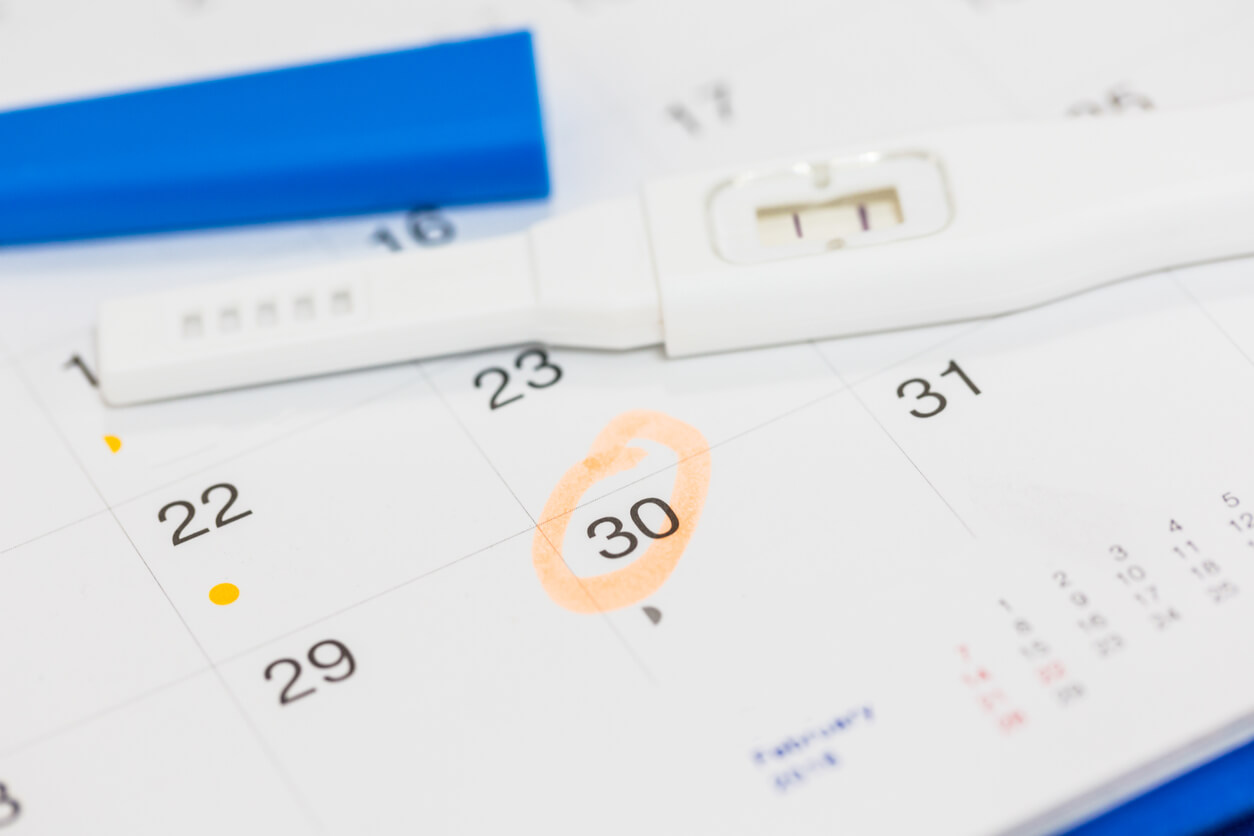hCG Levels During Pregnancy: How to Interpret Them?

During pregnancy, hCG levels (human chorionic gonadotropin levels) tend to rise considerably, especially during the first trimester. This is because this substance is in charge of “calling the shots” in several gestational processes and changes that occur in the maternal body.
hCG is a useful parameter both to confirm pregnancy and to detect possible alterations, both maternal and fetal. Therefore, today we’re going to tell you how to interpret the results obtained in blood tests so that you can orient yourself before your doctor’s appointment.
What is hCG?
Let’s start by describing human chorionic gonadotropin (hCG), also known as the pregnancy hormone. This substance is secreted by embryonic trophoblast cells, which are the cells that will give rise to the placenta. Therefore, it’s produced when the woman is pregnant.
During the first days of gestation, hCG increases rapidly and remains at a steady rise until the end of the first trimester. Thereafter, it tends to decrease and stabilize.
hCG contributes to the maintenance of pregnancy and, among its functions, stimulates the production of other key hormones, such as progesterone and estrogens. In addition, it favors the nutrition of uterine tissue and participates in different processes of growth and multiplication of the cells of the future baby.
The hormone that confirms pregnancy
Its specificity for gestation and its rapid detection in blood and urine make hCG an excellent marker of pregnancy and consequently, several tests involving it have been developed:
- Qualitative hCG, which detects whether this hormone is present in the blood.
- Quantitative hCG (or beta-hCG), which measures the amount of hormone present in the blood and allows the values to be compared with those of the previous or subsequent days.
In addition to laboratory determinations, there are home pregnancy tests to detect this hormone in urine. However, they must be performed 10 to 14 days after conception, as they require a certain concentration of hCG in the blood to detect it.

Normal values of hCG during pregnancy
When the physician orders a quantitative hCG test, he does so to evaluate the amount of hormone in the blood for various purposes and to detect the following conditions:
- Ongoing pregnancy and to estimate the week of gestation.
- Early gestational problems, such as miscarriage or ectopic pregnancy.
- Germ cell tumors, such as hydatidiform mole.
- The risk of Down syndrome. The hCG values are also taken into account to assess possible fetal congenital anomalies in the triple screening. This test is performed between 15 and 20 weeks of gestation in most pregnant women.
According to the American Pregnancy Association, hCG values in pregnancy follow a trend from the date of the last menstrual period. These are measured in international milliunits per milliliter of blood (mIU/ml) and are as follows:
- 3 weeks: 5 – 50 mIU/ml.
- 4 weeks: 5 – 426 mIU/ml.
- 5 weeks: 18 – 7,340 mIUI/ml.
- 6 weeks: 1,080 – 56,500 mIU/ml.
- 7 – 8 weeks: 7,650 – 229,000 mIU/ml.
- 9 – 12 weeks: 25,700 – 288,000 mIU/ml.
- 13 – 16 weeks: 13,300 – 254,000 mIUI/ml.
- 17 – 24 weeks: 4,060 – 165,400 mIU/ml.
- 25 – 40 weeks: 3,640 – 117,000 mIUI/ml.
- Non-pregnant women: <5.0 mIUI/ml.
- Postmenopausal women: <9.5 mIU/ml.
So, if hCG levels are less than 5 mIU/ml the woman isn’t pregnant, but above 25 mIU/ml, the test value is considered positive for pregnancy.
How are hCG levels interpreted during pregnancy?
hCG levels rise exponentially when the fertilized egg implants in the uterine walls, which happens about 10 days after conception. Thereafter, with each passing day, the blood concentration increases throughout the first trimester.
hCG levels rise rapidly during the first 12 to 16 weeks of pregnancy, peaking around 14 weeks of pregnancy.
When the physician orders a serial hCG test, i.e. 2 quantitative tests separated by a period of 48 to 72 hours, this confirms that the pregnancy is proceeding as expected. If the results aren’t as expected, other diagnostic studies will be performed.
hCG as an indicator of problems in pregnancy
By evaluating the trend of hCG in maternal blood, possible alterations can be detected during the first trimester of pregnancy. These conditions vary depending on whether the hormone values are below or above what’s expected for the post-conceptional week.

Below normal values
When hCG levels are lower than expected in the first test, it’s likely that the doctor will order a second test to confirm. If they remain at this level, the risk of threatened miscarriage is defined. In addition to this diagnosis, they may indicate an incomplete miscarriage or an ectopic pregnancy.
Above normal values
Conversely, when hCG levels are higher than expected, they may indicate a twin or multiple pregnancy. Also, it may suggest some pathological conditions, such as hydatidiform mole, choriocarcinoma, or other types of cancer.
Regarding hCG levels during pregnancy, we can say
Analyzing hCG values during pregnancy is a specialist’s task, however, it’s worth knowing what their results mean at the time of determination studies.
As we always suggest, the best way to take care of your baby on the way is to follow your gynecologist’s instructions precisely and attend routine health check-ups to discuss this and other aspects.
During pregnancy, hCG levels (human chorionic gonadotropin levels) tend to rise considerably, especially during the first trimester. This is because this substance is in charge of “calling the shots” in several gestational processes and changes that occur in the maternal body.
hCG is a useful parameter both to confirm pregnancy and to detect possible alterations, both maternal and fetal. Therefore, today we’re going to tell you how to interpret the results obtained in blood tests so that you can orient yourself before your doctor’s appointment.
What is hCG?
Let’s start by describing human chorionic gonadotropin (hCG), also known as the pregnancy hormone. This substance is secreted by embryonic trophoblast cells, which are the cells that will give rise to the placenta. Therefore, it’s produced when the woman is pregnant.
During the first days of gestation, hCG increases rapidly and remains at a steady rise until the end of the first trimester. Thereafter, it tends to decrease and stabilize.
hCG contributes to the maintenance of pregnancy and, among its functions, stimulates the production of other key hormones, such as progesterone and estrogens. In addition, it favors the nutrition of uterine tissue and participates in different processes of growth and multiplication of the cells of the future baby.
The hormone that confirms pregnancy
Its specificity for gestation and its rapid detection in blood and urine make hCG an excellent marker of pregnancy and consequently, several tests involving it have been developed:
- Qualitative hCG, which detects whether this hormone is present in the blood.
- Quantitative hCG (or beta-hCG), which measures the amount of hormone present in the blood and allows the values to be compared with those of the previous or subsequent days.
In addition to laboratory determinations, there are home pregnancy tests to detect this hormone in urine. However, they must be performed 10 to 14 days after conception, as they require a certain concentration of hCG in the blood to detect it.

Normal values of hCG during pregnancy
When the physician orders a quantitative hCG test, he does so to evaluate the amount of hormone in the blood for various purposes and to detect the following conditions:
- Ongoing pregnancy and to estimate the week of gestation.
- Early gestational problems, such as miscarriage or ectopic pregnancy.
- Germ cell tumors, such as hydatidiform mole.
- The risk of Down syndrome. The hCG values are also taken into account to assess possible fetal congenital anomalies in the triple screening. This test is performed between 15 and 20 weeks of gestation in most pregnant women.
According to the American Pregnancy Association, hCG values in pregnancy follow a trend from the date of the last menstrual period. These are measured in international milliunits per milliliter of blood (mIU/ml) and are as follows:
- 3 weeks: 5 – 50 mIU/ml.
- 4 weeks: 5 – 426 mIU/ml.
- 5 weeks: 18 – 7,340 mIUI/ml.
- 6 weeks: 1,080 – 56,500 mIU/ml.
- 7 – 8 weeks: 7,650 – 229,000 mIU/ml.
- 9 – 12 weeks: 25,700 – 288,000 mIU/ml.
- 13 – 16 weeks: 13,300 – 254,000 mIUI/ml.
- 17 – 24 weeks: 4,060 – 165,400 mIU/ml.
- 25 – 40 weeks: 3,640 – 117,000 mIUI/ml.
- Non-pregnant women: <5.0 mIUI/ml.
- Postmenopausal women: <9.5 mIU/ml.
So, if hCG levels are less than 5 mIU/ml the woman isn’t pregnant, but above 25 mIU/ml, the test value is considered positive for pregnancy.
How are hCG levels interpreted during pregnancy?
hCG levels rise exponentially when the fertilized egg implants in the uterine walls, which happens about 10 days after conception. Thereafter, with each passing day, the blood concentration increases throughout the first trimester.
hCG levels rise rapidly during the first 12 to 16 weeks of pregnancy, peaking around 14 weeks of pregnancy.
When the physician orders a serial hCG test, i.e. 2 quantitative tests separated by a period of 48 to 72 hours, this confirms that the pregnancy is proceeding as expected. If the results aren’t as expected, other diagnostic studies will be performed.
hCG as an indicator of problems in pregnancy
By evaluating the trend of hCG in maternal blood, possible alterations can be detected during the first trimester of pregnancy. These conditions vary depending on whether the hormone values are below or above what’s expected for the post-conceptional week.

Below normal values
When hCG levels are lower than expected in the first test, it’s likely that the doctor will order a second test to confirm. If they remain at this level, the risk of threatened miscarriage is defined. In addition to this diagnosis, they may indicate an incomplete miscarriage or an ectopic pregnancy.
Above normal values
Conversely, when hCG levels are higher than expected, they may indicate a twin or multiple pregnancy. Also, it may suggest some pathological conditions, such as hydatidiform mole, choriocarcinoma, or other types of cancer.
Regarding hCG levels during pregnancy, we can say
Analyzing hCG values during pregnancy is a specialist’s task, however, it’s worth knowing what their results mean at the time of determination studies.
As we always suggest, the best way to take care of your baby on the way is to follow your gynecologist’s instructions precisely and attend routine health check-ups to discuss this and other aspects.
All cited sources were thoroughly reviewed by our team to ensure their quality, reliability, currency, and validity. The bibliography of this article was considered reliable and of academic or scientific accuracy.
- American Pregnancy Association (2021) Gonadotropina Coriónica Humana (GCH): La Hormona del Embarazo. Recuperado de: https://americanpregnancy.org/es/getting-pregnant/hcg-levels/
- Barrera, D. (2008). Mecanismos de regulación de la síntesis y secreción de la gonadotropina coriónica humana (hCG) durante el embarazo. Revista de Investigación Clínica / Vol. 60, Núm. 2 / Marzo-Abril, 2008 / pp 124-132.
- Organización mundial de la salud OMS (2003). Interés clínico: Gonadotropina Coriónica Humana (HCG). Recuperado de: https://www.paho.org/cub/dmdocuments/BIO%20CIE%20UMELISA%20HCG.pdf
- Velázquez, N. (2014). La hormona gonadotrofina coriónica humana. Una molécula ubícua y versátil. Parte I. Revista Obstetricia y Ginecología Venezuela Vol.74 Nº.2 Caracas jun. 2014.Recuperado de: http://ve.scielo.org/scielo.php?script=sci_arttext&pid=S0048-77322014000200006
This text is provided for informational purposes only and does not replace consultation with a professional. If in doubt, consult your specialist.








